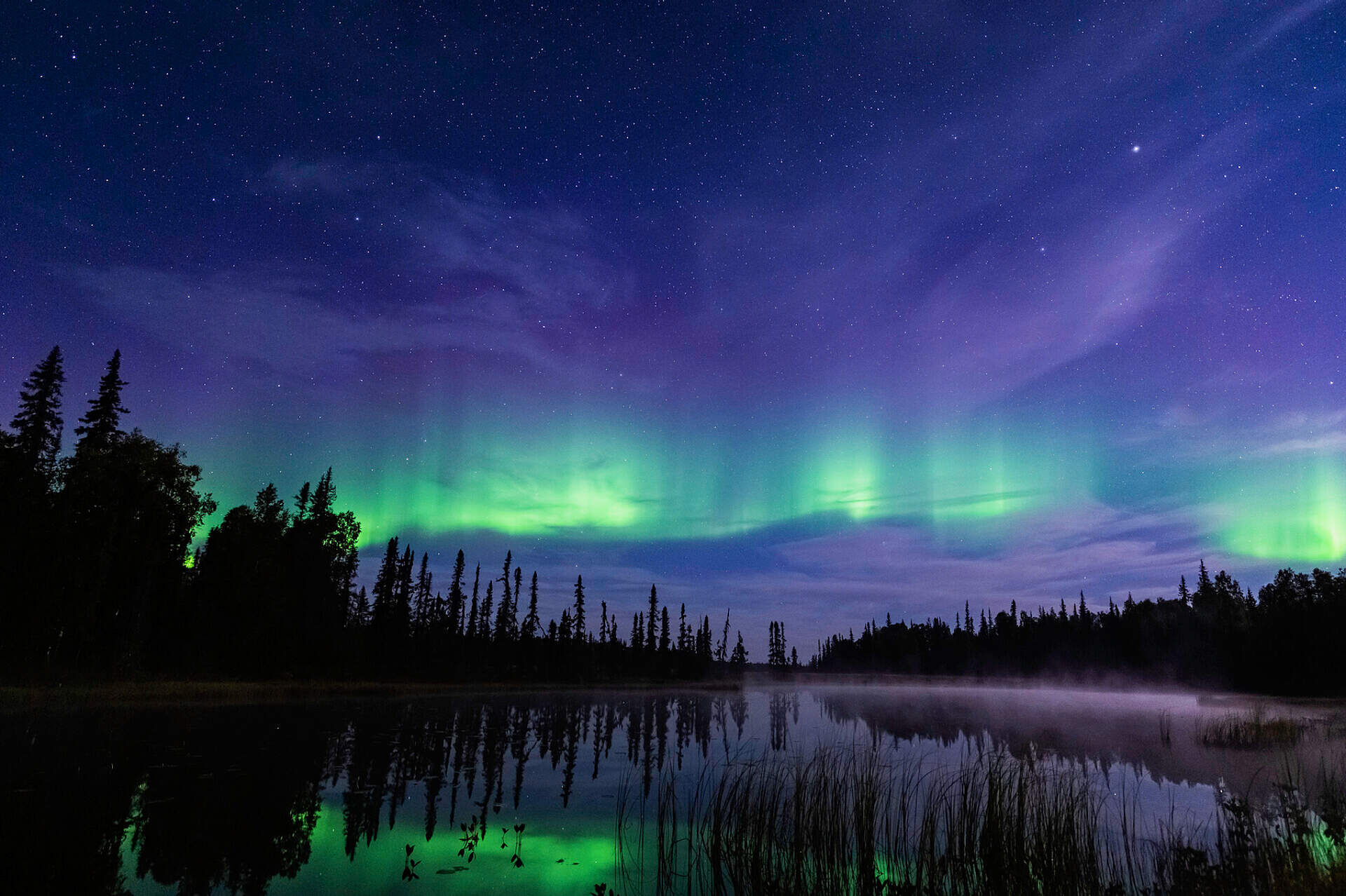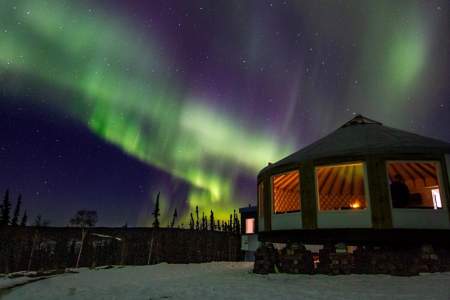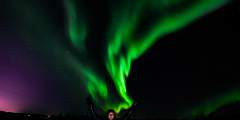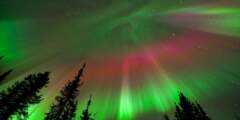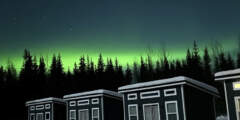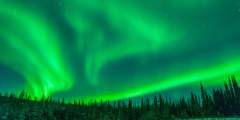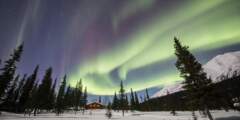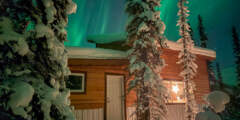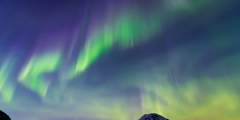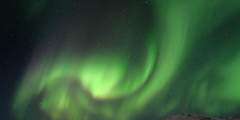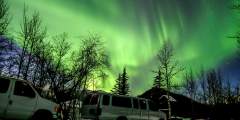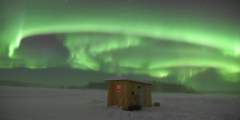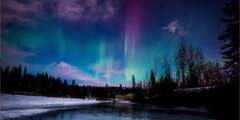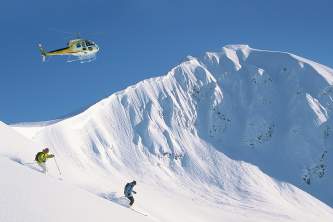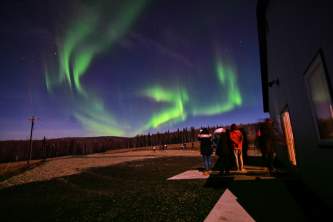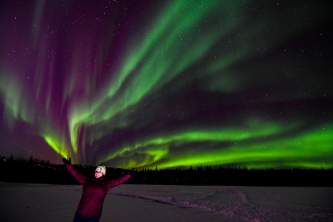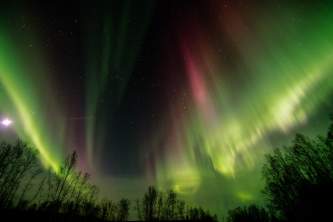Alaska Northern Lights Viewing
When is the Best Time to See the Northern Lights in Alaska?
The best time to see the northern lights in Alaska is from late August to mid-April, when the nights are long and dark. (You won’t see them during the summer months because of Alaska’s midnight sun.) Plan to look for the spectacular, multi-colored lights from 11 p.m. to 2 a.m., when the sky is at its darkest and the auroras are the most active.
Where to Go to See the Aurora Borealis in Alaska?
Fairbanks and points north are the sweet spots to see the northern lights. This is because the main auroral band, the ring of geomagnetic particles around the Arctic Circle where the Northern Lights are most visible, crosses the state in an arc above the Alaska Range. Fortunately, it’s easy to get there: You can fly into Fairbanks and be at a world-class aurora-viewing venue in under an hour.
Find a Northern Lights Tour
While you can look for the lights on your own, taking a northern lights tour in Alaska is an easier, more efficient way to go. You’ll have a guide who will take you to the best viewing spots and explain the science behind this natural phenomenon. Most tours will also provide warm clothing and hot beverages so you can stay comfortable and enjoy the show! Jump to List of Tours
Clear-Roofed Igloos
Gaze up at the northern lights from your private Igloo, just north of Fairbanks
Located on a quiet ridgeline outside of Fairbanks, the Borealis Basecamp offers 20 elegant igloos and a new village with 5 aurora-viewing cubes, including a family suite custom-designed and specifically positioned to maximize your viewing of the Northern Lights. You’ll also have the chance to take advantage of the camps many winter activities like dogsledding, snowmachining, snowshoeing, and fat-tire biking.
Evening Viewing, Short Drive from Fairbanks or Anchorage
Just a short 15-minute drive from downtown Fairbanks, wait for the northern lights to appear in a warm, inviting space. Cozy up to the fire, sip on cocoa and coffee, and step outside when mother nature puts on a show. Although the center is a short distance from town, it is far enough away so that you won’t have to worry about light pollution interrupting your view as you stand gazing under the vast, starlit sky.
Multi-Day Winter Vacation
Experience Alaska's iconic winter activities + northern lights viewing
$4695
8 Days
Visits: Fairbanks
Land Package Type: Adventure Tours
The chance to witness the otherworldly phenomenon of the aurora borealis is the centerpiece of this 8‑day tour in northern Alaska — and you’ll have several evenings to hunt for the mystical northern lights dancing across the sky. But there are plenty of other sights to enjoy along the way as well, like the Trans-Alaska Pipeline, Pioneer Park, and Chena Hot Springs. You’ll also go dog mushing, meet reindeer, and try your hand at curling. ...more
Just 60 miles north of Anchorage, in the heart of the Hatcher Pass Recreation Area of the Talkeetna Mountains, you can experience amazing tours, comfortable lodging, and hearty meals at Snowhook Adventures’ Lodge and Cabins. Whether you’re here in winter, spring, summer or fall, you can enjoy all-inclusive overnight experiences. Depending on the season, these tours include ATV/UTV riding, dog sledding, snowmobiling, ice fishing, northern lights ...more
Wondering how folks up here deal with Alaska’s long winter days? It’s easy when the inky night sky comes alive with an amazing light show like the aurora borealis. Braving the cold is nothing if you get a chance to see the lights dancing and waving overhead. Combine your aurora viewing trip with a few other highlights planned out by Salmon Berry Tours, and you’ll experience the best of winter in Alaska.
All-Inclusive Wilderness Lodge
View the aurora from the comfort of a wilderness lodge in the Brooks Range near Gates of the Arctic National Park
This family-owned, fly-in luxury wilderness lodge is 200 miles north of Fairbanks and 60 miles above the Arctic Circle. Stays are all-inclusive and exclusive — they only accept one group at a time. Go dogsledding, snowshoeing, or scan the skies for the northern lights. The lodge’s huge picture windows make it easy to keep a lookout for the aurora from a warm, comfortable interior.
This remote, off-grid retreat center, which sits 63 miles above the Arctic Circle, offers a truly authentic getaway, complete with a menu of enriching programs. Wellness-based transformational experiences are the focus. Depending on the retreat, you can opt for activities like yoga, meditation, art, hiking, skiing, rafting, dogsledding, and even a chance to view the northern lights.
Photography Tours
Tours from Anchorage. Learn how to photograph the northern lights. Non-photographers are welcome to enjoy the show and have their photo taken.
Photograph alpenglow on snow capped mountains, frosty scenes glowing in rich winter light, wildlife wandering snowy paths, city lights reflecting on the water at twilight, and possibly even the northern lights!
Arctic Circle Fly, Drive and Overnight Adventures
Drive north (or fly) from Fairbanks to the Arctic Circle
Stand out on the Arctic tundra under the northern lights, experiencing their eerie glow on a one-day tour you won’t soon forget. From October to April, you’ll depart from Fairbanks on this one-day adventure and get a majestic flightseeing trip to the remote town of Coldfoot, above the Arctic Circle. Explore this fascinating town and look for the mysterious lights overhead. Then drive south and get a close up of all the terrain in between, seeing ...more
Spend some time above the Arctic Circle under the mysterious, eerie northern lights. From mid-September to late April, when you have the best chance of witnessing phenomenon of the aurora borealis, you’ll fly from Fairbanks to the remote village of Coldfoot, in the Brooks Mountain Range. After the spectacular flightseeing experience, you’ll have either 3 days/2 nights or 4 days/3 nights to explore this rugged, fascinating landscape, with ...more
Aurora Ice Fishing
Spend the evening ice fishing from a warm hut, situated in an unobstructed viewing location
Seeing the Northern Lights is an unforgettable wintertime experience. Of course, you never know quite when (or even if) Mother Nature is going to unleash the display into the night sky. So while you wait, you’ll be trying your hand at another activity that’s unique to the Alaskan winter: ice fishing!
Aurora + Hot Springs
Soak in the healing waters of Chena Hot Springs, a prime location to view the lights if the forecast is good!
Join Alaska Wildlife Guide in exploring one of Alaska’s most desired attractions, Chena Hot Springs Resort. From visiting the most northern Ice Museum, soaking in the all-natural hot springs to viewing the breathtaking Northern Lights dance across the sky, this tour will be a highlight of your Alaskan experience.

